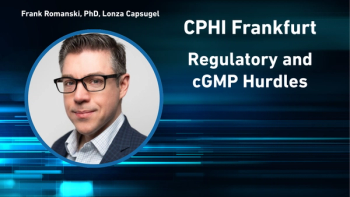
- Pharmaceutical Technology-09-02-2019
- Volume 43
- Issue 9
More Predictable Post-Approval Change Policy on Horizon
Industry and regulators seek global system that reduces regional differences.
Regulatory officials in the United States, Europe, and other regions are collaborating with manufacturers to advance a new framework for managing chemistry, manufacturing, and controls (CMC) changes more efficiently across the product lifecycle. The process is outlined in the Q12 guideline developed by an expert working group formed under the
Support for a harmonized approach for authorizing new manufacturing and testing methods on approved drugs and biologics reflects general agreement on a risk-based system for categorizing and managing changes, despite continuing differences among authorities over specifics for reduced oversight of certain variations. In the works formally since 2014, the Q12 guideline is expected to provide flexible oversight of post-approval changes with reduced regulatory reporting for manufacturers able to demonstrate enhanced knowledge about product, manufacturing process, and analytical procedures, as provided by a company’s product quality system (PQS).
A key feature of Q12 outlines how manufacturers should define those established conditions (ECs) that are considered necessary to assure product quality. Thus, a change to an EC would require a regulatory submission, explained Chikako Torigoe, biologist in the office of the director of FDA’s Center for Biologics Evaluation and Research (CBER). At the same time, those parameters that have less risk of impacting product quality or process consistency would not be considered ECs and could be managed by a manufacturer’s internal PQS and implemented without prior approval, Torigoe noted at the July 2019 CMC Forum sponsored by CASSS (2).
Manufacturers may reduce ECs requiring regulatory approval through development and submission of a post-approval change management protocol (PACMP) that describes anticipated changes to a product or products. The PACMP would provide the basis for agreement between the applicant and regulatory authority about information required to support certain changes. PACMPs could involve multiple products, as with establishing a new process to improve product sterility assurance, upgrades to a vial wash room, or introducing a new product to a manufacturing facility. FDA is launching a pilot program to gain experience in assessing proposed ECs, with the aim of reviewing nine submissions of new drugs, generics, and biotech products to see how much time and effort is involved in identifying ECs at time of approval.
An approach similar to Q12 already has been established in Japan, pointed out Tomonori Nakagawa, API project manager at Otsuka Pharmaceutical Co., at the CASSS Forum. This initiative by Japan’s Pharmaceuticals and Medical Devices Agency (PMDA) has produced a more efficient program for overseeing a robust change management system, he noted, based on a demonstration of product and process knowledge. And Health Canada is ready to implement ICH Q12, reported senior regulatory scientist Anthony Ridgway at Health Canada’s Biologics & Genetic Therapies Directorate. That agency has issued guidance on categories, conditions, and data expected for different reporting categories, and policies already are aligned to provide flexibility in defining ECs and in justifying reduced reporting. Health Canada encourages adoption of risk-based categorization of post-approval changes that require only notification or listing in an annual report, Ridgway said, adding that more work is needed to better define and align with ICH recommendations for PACMPs.
Kavita Vyas, policy lead in the Office of Policy for Pharmaceutical Quality in the Center for Drug Evaluation and Research (CDER), described ongoing FDA efforts to prepare to meet Q12 challenges. An agency group is examining case studies related to established conditions and anticipates gaining useful learnings from the upcoming pilot project. Alexey Khrenov, senior staff fellow at CBER’s Office of Tissues and Advanced Therapies (OTAT), noted that training is being developed to familiarize reviewers with Q12 approaches. Greater regulatory flexibility should benefit manufacturers, he commented, although the specifics for defining ECs and for assessing PACMP and product lifecycle management (PLCM) documents remains uncertain.
Encouraging improvement
Despite the challenges, manufacturers hope to move forward with Q12 as more products are tested, produced, and distributed in multiple regions, creating complex supply chains that trigger diverse testing requirements and inspection processes. It can take four to six years to add a new site or comply with a new standard for a product that is approved and distributed globally, noted Nakagawa. Similarly, consultant Moheb Nasr, formerly with FDA and Amgen, described how the current system discourages firms from adopting more efficient laboratory test methods and modern production systems.
Many manufacturers look to advance strategies for managing CMC changes under the firm’s PQS, as supported by a series of earlier ICH quality guidelines (Q8–11). Leslie Bloom, executive director of regulatory CMC at Pfizer, described efforts to develop PLCM plans to manage ECs over the product lifecycle even before Q12 is finalized. And ongoing efforts aim to provide more justification for a range of risks related to ECs and non-ECs, especially in process and analytical methods.
Kimberly Wolfram, director of global regulatory affairs CMC at Biogen, described herself as a “realist” in anticipating the benefits from Q12 after years of effort. While she hopes for less confusion in regional adoption of ECs and guidelines, she and others acknowledge challenges in gaining global alignment on change management protocols based on risk assessment to enhance access to therapies.
References
1. ICH, Q12,
2. CASSS, “The Future of Post-approval Changes is Coming–Are You Ready for ICH Q12?” Conference (Gaithersburg, MD, July 2019).
Article Details
Pharmaceutical Technology
Vol. 43, No. 9
September 2019
Pages: 14-15
Citation
When referring to this article, please cite it as J. Wechsler, "More Predictable Post-Approval Change Policy on Horizon," Pharmaceutical Technology 43 (9) 2019.
Articles in this issue
over 6 years ago
Pharma’s Got Talent?over 6 years ago
The Big Deal Behind the ‘No-Deal’ Scenarioover 6 years ago
EMA’s Regulatory Impact: Not Yet in its PRIMEover 6 years ago
Using Digital Tools to Optimize Facility Designover 6 years ago
The Road to Real-Time Release: At-line NIR Testingover 6 years ago
Putting NIR to Good Use in Tablet Formulation and Manufactureover 6 years ago
Improved Mixer Lift and Seal Designsover 6 years ago
Mass Flow ControllersNewsletter
Get the essential updates shaping the future of pharma manufacturing and compliance—subscribe today to Pharmaceutical Technology and never miss a breakthrough.




